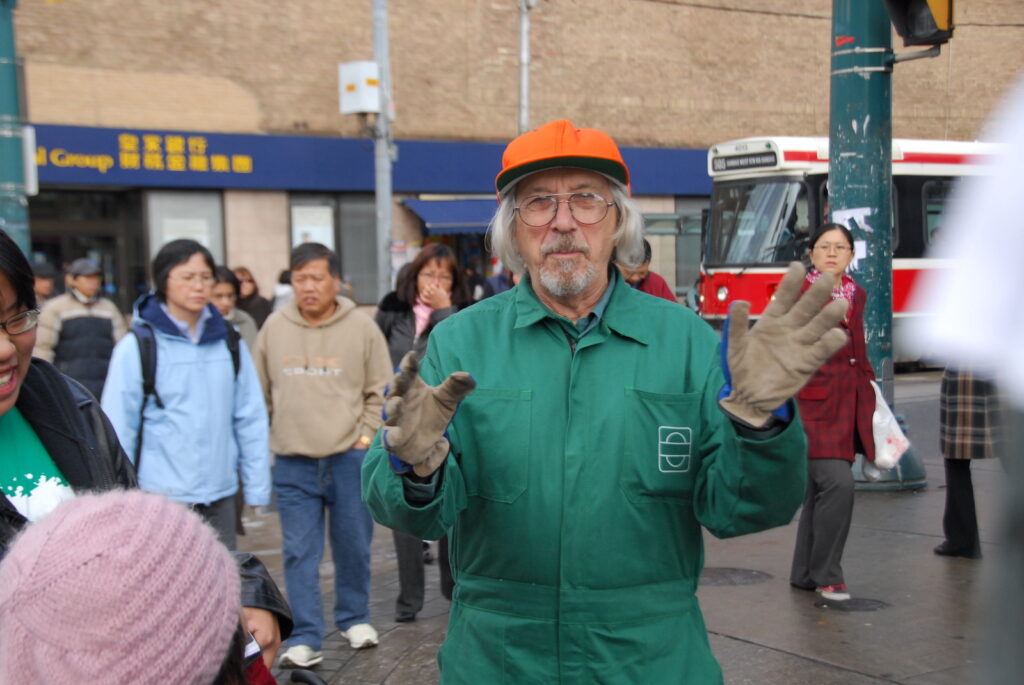By Elaine Wong
After the audience is finished processing the events of Chaw Ei Thein‘s performance in the Toronto Free Gallery, we turn our attention to the other half of the room which is dominated by a large structure made out of lattice work and wood. A giant square base morphs into an octagonal second layer, which (once the performance has started) will be dominated at its top by a skeletal dome.
Glenn Lewis, renowned both as an artist in a variety of forms and as an environmentalist, has weathered many artistic movements over his many years in the performance art world, though he muses that he does not belong to a specific group or movement any more. While he does not perform very often any more, having concentrated his efforts on his gardens where he breeds lilies, he tells me that the structure he has created recalls themes in his life involving shapes, circles and knots working in on themselves. This theme encompasses performances ranging from his very first to the hexagonal house he has built in British Columbia.
Having started his artistic endeavours in visual art and ceramics, he cites his interest in performance stemming from a workshop led by Deborah Hay that he attended while part of the intermedia movement: a movement concerned with crossing established boundaries by combining different media, forms and sources of inspiration (dream, movement, material) to create poetic combinations in art. At this workshop, he created his first performance in which he opened up an umbrella full of flour and raked the flour into swirls and shapes (in a fashion similar to Japanese rock gardens) in time to a radio playing in his pocket.
In the performance we see today, Lewis, clad in his green jumpsuit and orange hat, begins by constructing a tower in the centre of the structure out of various found objects (including an old stereo system, a CD rack and an impromptu bird cage), at the top of which sits a purple and yellow stuffed bird. From the top of the cage sprouts eight grey foam tubes, which Lewis balances on nails to create the domed ceiling of the sanctuary. A CD of Abyssinian music plays in the background as the two videos of the walking/sweeping portion of this performance are displayed side by side on the wall, and we watch the dual Lewises as they progress along the sidewalks of Toronto.
In my interview with Lewis about his piece, I mentioned that I felt that he went out of his way to create an atmosphere of help and positivity in these walks, emphasized by his jumpsuit reading ‘HOPE Engineering’ and his random acts of kindness. I was curious if he felt that his art stemmed from a desire to create positive social relations. His answer was yes, but not necessarily in a conscious way; in fact, no more deliberately than his everyday life. About the potential for performance art, and art in general, to change society for the better, he would like to think this is possible, but added that it’s probably not a good idea for artists to be in any sort of political power. He does hope, again in an offhand kind of way, that his performance would provide the audience with an awareness of the sheer mass of the commodity life we lead and all the garbage we produce on a daily basis. But, he emphasized, preaching is not at all the intention of the piece—the piece is more like a collage, incorporating aspects of the street with aspects of the festival’s ideals of art and performance.
And indeed, as he strews bags of garbage around the structure, his performance is much more light-hearted and fun-loving than my questions about social change. He almost revels in the garbage as he shuffles in circles inside the structure, clearing a path. It is the vision of the sanctuary in Evelyn Waugh’s short story that he wants to recreate, especially its unexpected nature, the masses of junk and the feeling of timelessness, of motion stopped. The structure does set a striking image with the homeliness of the lattice walls combined with the black metal of the central tower and the piles of trash. We aren’t quite sure how to processes this combination of images, as is evidenced in some audience members’ reluctance to join Lewis inside the structure for his circle dance (although this is probably also people’s reluctance to get their shoes dirty). But, after gathering up those brave audience members he can, they dance together with him around the central tower, kicking up the garbage as they go first in one direction and then the other.
Overall, Lewis stated earlier to me that, if anything, he wanted to give the audience an experience, something that they wouldn’t normally do—like walking through a very odd sand. A sand constructed at the crossroads of daily life and history, between discarding and reclaiming. He wanted to make a hidden experience, and I believe that the most important hidden part of this experience is how celebratory of life it is, despite the potential to read the piece as a criticism of modern society. Lewis is not someone who disparages or destroys, but someone who supports people and life through his art.

